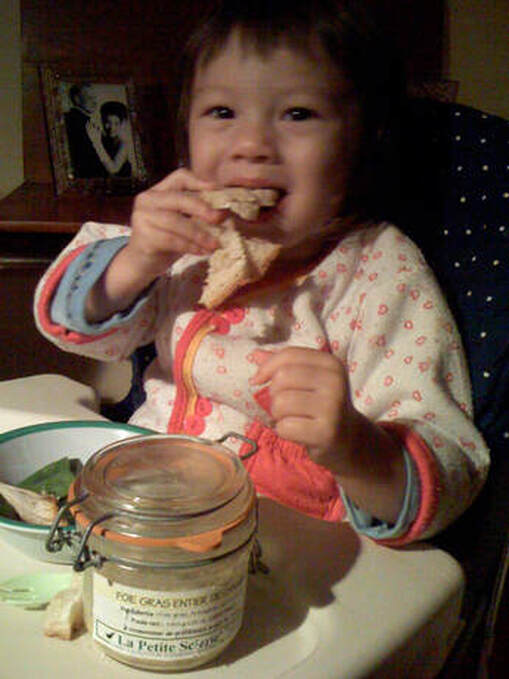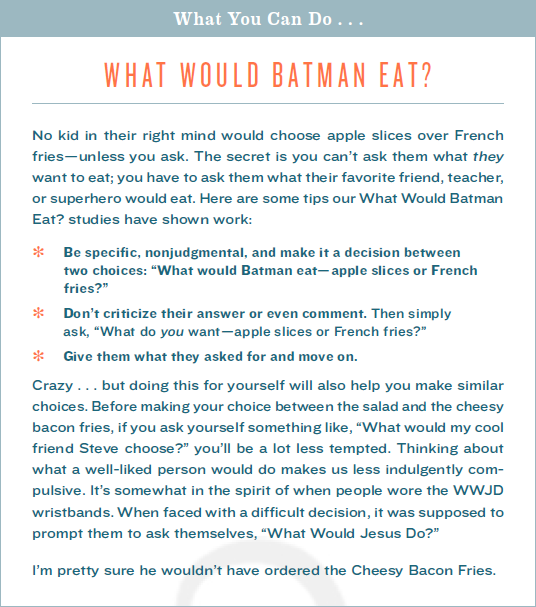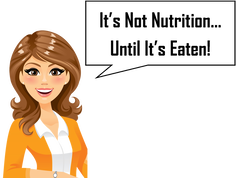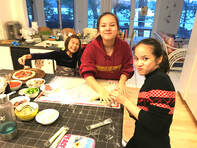"The Nutritional Gatekeeper controls around 72% of what your family eats."
- Mindless Eating
|
Some FAQs from Parents |
What Kind of Cook are You? |
|
• How can I control what my family eats?
• Do kids inherit their taste for different foods? • How can I condition my kids to like healthier food? • What's wrong with telling my kids to clean their plate? • How do I stop my kids from overeating? • How can I make healthier meals my family will eat? • My kids complain about my food. What can I do? • Is there an easy way to become a good cook? • What are 3 ways I can improve how my kids eat? • Will my child grow up to be overweight? |
If you know your cooking style, you can make things more fun for you and more meaningful for your family. |
The Nutritional Gatekeeper and the Good Cook Next Door
|
In most households, decisions about what to eat for breakfast, lunch, dinner, and snacks are determined by what foods the grocery shopper—the nutritional gatekeeper—brings into the house. Although they don’t always realize it, gatekeepers powerfully shape what food gets eaten both inside and outside the house.(1)
Suppose a teenager wants to eat Pop-Tarts, but there aren’t any in the cupboard? The gatekeeper has defacto decided they won’t be on the menu. This poor Pop-Tart hungry teenager either has to make a special trip to the grocery store, or pressure Mom or Dad to put them at the top of the next shopping list. |
|
Exactly how much influence does a gatekeeper have?
On a steamy Manila-like August morning in Washington, D.C., in 2005, I met with hundreds of dietitians nurses, and physicians at a conference of the American Association of Diabetes Educators. These experts are paid to know how people shouldeat and how they do eat. They watch their diabetic patients— and their families—eat day in and day out. I asked them about the nutritional gatekeeper, the person who does most of the shopping and cooking in a household (around 90 percent of the time this is the same person). I asked them to estimate what percentage of the food eaten by these families—snacks, meals, out-of-the-house meals, everything—is controlled by the gatekeeper. Their answers surprised me.
They estimated that the gatekeeper controlled 72 percent of the food decisions of their children and spouse.(2) After all, they were the ones who bought almost everything that was eaten at home, they were the ones who either made their children’s lunches or gave them lunch or snack money, and they were the ones who influenced family restaurant orders by what they recommended or ordered themselves.
We have since asked over 2,500 parents to estimate this percentage. Some were 10 points lower or 10 points higher, but the answer was always in the same range. Only one group stood out, because their estimates were consistently high. These were people who also rated themselves as “good cooks.” This made some sense. It was in line with a study we did that showed that many veggie lovers claimed either to be a good cook, to live with a good cook, or to have had a parent who was a good cook. But exactly who were these good cooks, and why were they so influential?
On a steamy Manila-like August morning in Washington, D.C., in 2005, I met with hundreds of dietitians nurses, and physicians at a conference of the American Association of Diabetes Educators. These experts are paid to know how people shouldeat and how they do eat. They watch their diabetic patients— and their families—eat day in and day out. I asked them about the nutritional gatekeeper, the person who does most of the shopping and cooking in a household (around 90 percent of the time this is the same person). I asked them to estimate what percentage of the food eaten by these families—snacks, meals, out-of-the-house meals, everything—is controlled by the gatekeeper. Their answers surprised me.
They estimated that the gatekeeper controlled 72 percent of the food decisions of their children and spouse.(2) After all, they were the ones who bought almost everything that was eaten at home, they were the ones who either made their children’s lunches or gave them lunch or snack money, and they were the ones who influenced family restaurant orders by what they recommended or ordered themselves.
We have since asked over 2,500 parents to estimate this percentage. Some were 10 points lower or 10 points higher, but the answer was always in the same range. Only one group stood out, because their estimates were consistently high. These were people who also rated themselves as “good cooks.” This made some sense. It was in line with a study we did that showed that many veggie lovers claimed either to be a good cook, to live with a good cook, or to have had a parent who was a good cook. But exactly who were these good cooks, and why were they so influential?
We decided to track down the mysterious North American Good Cook, take some psychographic snapshots of the species, and decipher their influence. To do this, we surveyed over 300 “good cooks” who were considered “above average” by themselves and by at least one other member of their family. They came from a wide range of ethnicities, income levels, and education levels. Besides being good cooks, they all had one thing in common—they had never attended culinary school. Some had learned from a parent, others on their own; some cooked out of necessity, and some for fun. We asked them over 100 questions about how they cooked, what they cooked, when they cooked, what kind of person they were, and what they did in their spare time. We found that 82 percent of them fit fairly neatly into one of five personality profiles. We classified them as giving cooks, competitive cooks, healthy cooks, methodical cooks, or innovative cooks.(3)
All of these cooks—except one— appeared to help their families eat healthier. They did this largely through the wide variety of food they served. A varied menu makes eating more pleasurable and can lead family members to expand their tastes beyond the standard fatty, salty, sweet foods for which we have a natural hankering.
Which good cook seemed to have the least positive impact on adult eating habits? Interestingly enough, it was the most common one—the giving cook. Although giving cooks put the stamp of variety on their meals, it was mostly in the form of high-carb entrées, baked goodies, and desserts.
Does this mean that if you’re not a good cook, your children are destined to a lifetime of Domino’s Pizza and Fritos? No, of course not. One key take-away for us “not so great cooks” is the good we can do just by adding more variety to our meals. How? By 1) buying different foods, 2) trying new recipes (including ethnic ones), 3) substituting different ingredients (mainly vegetables and spices) into favorite recipes, 4) taking kids to the grocery store and letting them choose a new, healthy food, or 5) visiting authentic ethnic restaurants. (Sorry, McDonald’s is not a Scottish restaurant.)
When a child develops a taste for a wide range of foods, healthy foods can be more easily substituted for less healthy ones.(5) He or she may even discover favorites other than pizza, French fries, and Juicy Juice. Will your daughter learn tolove broccoli? Maybe not, but she’ll probably be more will- ing to eat it occasionally for dinner or with a low-calorie ranch dressing as a snack."
All of these cooks—except one— appeared to help their families eat healthier. They did this largely through the wide variety of food they served. A varied menu makes eating more pleasurable and can lead family members to expand their tastes beyond the standard fatty, salty, sweet foods for which we have a natural hankering.
Which good cook seemed to have the least positive impact on adult eating habits? Interestingly enough, it was the most common one—the giving cook. Although giving cooks put the stamp of variety on their meals, it was mostly in the form of high-carb entrées, baked goodies, and desserts.
Does this mean that if you’re not a good cook, your children are destined to a lifetime of Domino’s Pizza and Fritos? No, of course not. One key take-away for us “not so great cooks” is the good we can do just by adding more variety to our meals. How? By 1) buying different foods, 2) trying new recipes (including ethnic ones), 3) substituting different ingredients (mainly vegetables and spices) into favorite recipes, 4) taking kids to the grocery store and letting them choose a new, healthy food, or 5) visiting authentic ethnic restaurants. (Sorry, McDonald’s is not a Scottish restaurant.)
When a child develops a taste for a wide range of foods, healthy foods can be more easily substituted for less healthy ones.(5) He or she may even discover favorites other than pizza, French fries, and Juicy Juice. Will your daughter learn tolove broccoli? Maybe not, but she’ll probably be more will- ing to eat it occasionally for dinner or with a low-calorie ranch dressing as a snack."
Do Kids Inherit Their Taste for Foods?We sometimes hear that a child “inherited” their sweet tooth, or their love for vegetables, or for spicy foods from a parent. Although the genetics jury is still out, it is clear that children adopt some of their mother’s tastes when they are still snoozing away in the womb. For instance, pregnant women who drank carrot juice in their last trimester significantly increased how much their children preferred carrot-flavored cereal months later.[i]
Not only do they develop prenatal munchie preferences, children also start learning what they like and don’tlike before they are four months old. They do this by picking up on signals a parent or caretaker unconsciously gives about whether a food is tasty or not. This was first discovered in the Massachusetts Reformatory for Women during the 1940s. The women incarcerated here were able to keep children under 3 years of age and to frequently visit them and their carekeepers in the nursery. Records were kept on what the children ate, so it became suspicious when all of a sudden their juice preferences abruptly changed. The psychologist at the reformatory, Sibylle Escalona, began to suspect that the caretakers were unconsciously influencing what the children preferred.[ii] |
Her report starts out, “It came to attention accidentally that many of the babies under four months of age showed a consistent dislike for either orange or tomato juice.” She then went on to report that babies who had refused to drink orange juice for about three weeks would all of a sudden turn into orange juice lovers within two or three days. She traced these abrupt changes to changes in caretakers. Upon being interviewed, it was found that a couple of the new carekeepers had a strong preference for orange juice and a dislike for tomato juice. Somehow this was passed along to the four month infants.
But how? Interestingly, even two-day-old babies are thought to be able to imitate facial expressions of adults.[iii] It could be that these caretakers subconsciously showed subtle signs of acceptance or rejection based upon what they personally felt toward the foods. A fleeting smile or grimace might go a long way toward explaining why one baby has daddy’s sweet tooth and another has mommy’s love for vegetables. This also makes good sense that people feeding babies pretend to taste the food (Mmmm . . . yummy!”) and to open their mouths and play “airplane hanger” when feeding the little tykes.[iv]
Escalona’s accidental discovery has aged well. Watching someone smile or grimace when eating food scares elementary children away from even an otherwise tasty food.[v] And this also works with being friendly – you can attract more children to new foods with honey than with vinegar. When a friendly adult repeatedly gave children either canned unsweetened pineapple or cashews, they quickly learned to like this food more than when it was given to them by a less friendly adult.[vi]
It is not only our tastes that our children can inherit. It can also be our attitudes about food and eating. In one Yale study of normal weight one-year olds, mothers who were highly preoccupied with weight issues were more likely to be erratic in their behavior during meals. Sometimes, they urged their one-year-olds to eat more, sometimes to eat less, and sometimes they rushed their feedings. They were also much more emotionally aroused when feeding their babies compared to mothers who were not concerned with weight issues.[vii] Children see this anxiety and these food obsessions at a tender tabla rosa age.
Just as our children can inherit our eye color and hair color, they might also be behaviorally imprinted with our obsessions with food or with weight. Fortunately, when they start to talk we can even more quickly imprint a passion for balanced meals, smaller portions, vegetables, and fruits.[viii]
But how? Interestingly, even two-day-old babies are thought to be able to imitate facial expressions of adults.[iii] It could be that these caretakers subconsciously showed subtle signs of acceptance or rejection based upon what they personally felt toward the foods. A fleeting smile or grimace might go a long way toward explaining why one baby has daddy’s sweet tooth and another has mommy’s love for vegetables. This also makes good sense that people feeding babies pretend to taste the food (Mmmm . . . yummy!”) and to open their mouths and play “airplane hanger” when feeding the little tykes.[iv]
Escalona’s accidental discovery has aged well. Watching someone smile or grimace when eating food scares elementary children away from even an otherwise tasty food.[v] And this also works with being friendly – you can attract more children to new foods with honey than with vinegar. When a friendly adult repeatedly gave children either canned unsweetened pineapple or cashews, they quickly learned to like this food more than when it was given to them by a less friendly adult.[vi]
It is not only our tastes that our children can inherit. It can also be our attitudes about food and eating. In one Yale study of normal weight one-year olds, mothers who were highly preoccupied with weight issues were more likely to be erratic in their behavior during meals. Sometimes, they urged their one-year-olds to eat more, sometimes to eat less, and sometimes they rushed their feedings. They were also much more emotionally aroused when feeding their babies compared to mothers who were not concerned with weight issues.[vii] Children see this anxiety and these food obsessions at a tender tabla rosa age.
Just as our children can inherit our eye color and hair color, they might also be behaviorally imprinted with our obsessions with food or with weight. Fortunately, when they start to talk we can even more quickly imprint a passion for balanced meals, smaller portions, vegetables, and fruits.[viii]
Tricking a Tricky Eater -- What Would Batman Eat?
|
Millions of parents take their happy kids to fast food restaurants every day. Most of us don’t even try to get our kids to order the apple slices instead of the fries or to order the white milk instead of the juice. We’re there because we don't have the time, energy, or motivation to cook, and because we also don’t have the time, energy, or motivation to argue with our kids--especially when we’re the ones getting the fries with our Combo-meal.
My Cornell Food and Brand Lab has done about a hundred studies with little kids, and one totally “duh” finding we’ve made is that they can be stubbornly habitual in what they want to eat. If kids had French fries yesterday, they want them again today--it’s their default and it works for them. If you ask them if they want apple slices or French fries, they’ll answer before you finish your question. The secret might be in interrupting this default, so they push the reset button on the side of their brain--so they at least give apple slices a chance. Here’s an idea. Instead of asking them what they want, what if we ask them about someone they admire? If we ask them—without judgment--what a friend, teacher, Scout Leader, or their favorite superhero would choose, it might cause them to push that reset button and think again. Our code name for this study was, “What Would Batman Eat?” |
That summer we were helping sponsor a 4-H summer camp for elementary school kids, and one week we decided to treat them to their side-order choice at a local fast-food restaurant—either apple slices or French fries. Now, if you ask twenty children ages five to ten whether they want apple slices or French fries, the score will be French fries 19, apple slices 1. But the next week we tried something different. Instead of asking what they wanted, we asked, “What would Batman eat, apple slices or French fries?” After they answered for Batman, we’d ask, “What do you want to eat, apple slices or French fries?” This time, the number of kids who ordered apple slices jumped from 1 to 9—almost half of them.
We’ve done this a bunch of times in a bunch of different ways, and here’s what’s crazy. First, it doesn’t matter who you say: Batman, the Joker, their teacher, or their best friend. Simply having to answer for anyone else seems to make them think twice—and often change their order. Second, it doesn’t matter what they answer. They could precociously say that Batman or their third-grade teacher would eat French fries, but they’ll still order apple slices half the time.
The only thing that doesn’t work is if you ask them too early. If you ask them even fifteen minutes before they place their order, only 25 percent will still order apple slices. You can plan ahead, but don’t ask until you pull into the parking lot.
Within three days of our findings, the people my Lab changed the way we feed our kids. Anytime our kids are facing an either/or decision in a restaurant—milk or soft drink, fried or baked, green beans or macaroni—we casually ask them, “What would [______] eat?” Of course you have to regularly change up the name, but if you ask it nonjudgmentally, it’s amazing how many times they push their brain’s reset button and do the right thing. And if it doesn’t work this time, try using a different name next time. Now, back to the Bat Cave.
We’ve done this a bunch of times in a bunch of different ways, and here’s what’s crazy. First, it doesn’t matter who you say: Batman, the Joker, their teacher, or their best friend. Simply having to answer for anyone else seems to make them think twice—and often change their order. Second, it doesn’t matter what they answer. They could precociously say that Batman or their third-grade teacher would eat French fries, but they’ll still order apple slices half the time.
The only thing that doesn’t work is if you ask them too early. If you ask them even fifteen minutes before they place their order, only 25 percent will still order apple slices. You can plan ahead, but don’t ask until you pull into the parking lot.
Within three days of our findings, the people my Lab changed the way we feed our kids. Anytime our kids are facing an either/or decision in a restaurant—milk or soft drink, fried or baked, green beans or macaroni—we casually ask them, “What would [______] eat?” Of course you have to regularly change up the name, but if you ask it nonjudgmentally, it’s amazing how many times they push their brain’s reset button and do the right thing. And if it doesn’t work this time, try using a different name next time. Now, back to the Bat Cave.
Change School Lunch!School lunchrooms can make small changes to help kids eat better, and you can help. Below is a 1-page solution, and here's a 3-step plan to get there.
|
Have Fun Family MealsAre your family meals are almost nonexistent because things are too crazy, your kids are too distracted, and it's just not worth it? Fortunately, there's a number of solutions. Stay tuned.
|
Join the Parent PanelWe like to "road test" new discoveries with parents to see if they work in real life. If you'd like to be part of our volunteer Parent Panel, send us your email and join the team. Currently we're testing new ideas for more meaningful family meals (for parents who hate to cook).
| ||
Evidence-based Support and Published References
for Mindless Eating (Chapter 7)
- Excerpted from Mindless Eating: Why We Eat More Than We Think, NY: Bantam-Dell, 2006
- See “Focus on Nutritional Gatekeepers and the 72% Solution,” Journal of the American Dietetic Association,(September 2006). Interestingly, we’ve repeated this with a lot of different people. Good cooks, non-cooks, young parents, empty nesters, grandmothers, single moms. They vary a bit, but all end up estimating right around 72 percent.
- See “Profiling Nutritional Gatekeepers: Three Methods for Differentiating Influential Cooks,” Food Quality and Preference 14:4 (June 2003): 289–97.
- See "Marketing Nutrition: Soy, Functional Foods, Biotechnology, and Obesity" (Champaign: University of Illinois Press, 2005).
- See “Cooking Habits Provide a Key to 5 a Day Success,” Journal of the American Dietetic Assocation 104:11 (November 2004): 1648–50, with Keong-mi Lee.
- [39] This is an incredibly easy technique. The article’s short, but about 95% of what you need to know to use it you’ve already read: Brian Wansink, Mitsuru Shimizu, and Guido Camps (2012), “What Would Batman Eat? Priming Children to Make Healthier Fast Food Choices,” Pediatric Obesity, 7:2, 121-123.





